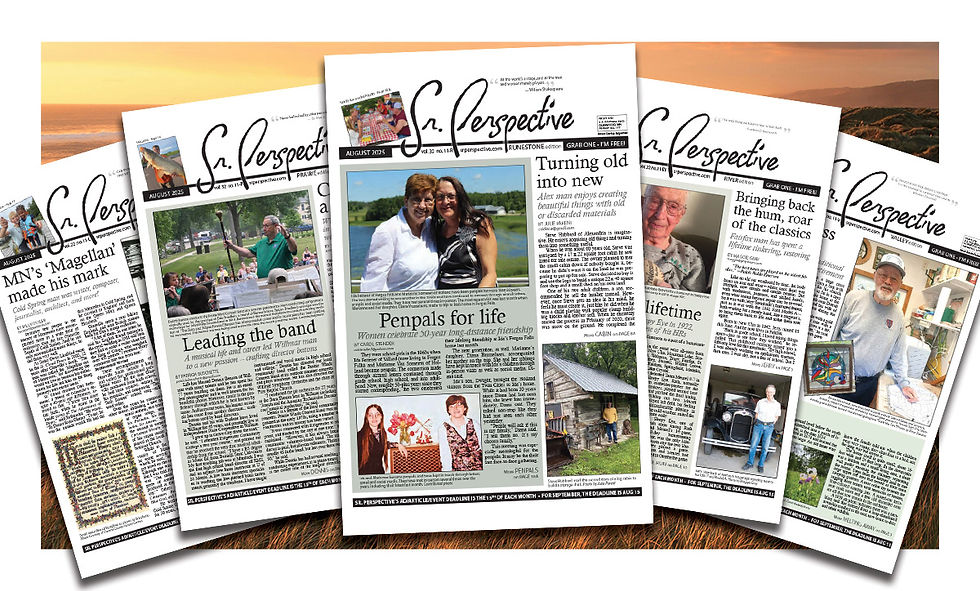Catching, sharing fish memorabilia
- Sr Perspective

- Sep 1, 2018
- 4 min read
Little Falls fishing museum is a man’s dream, fulfilled
Al Baert, of Sartell, once had a dream of becoming a really big time collector of fishing memorabilia. He never could have known that his dream would turn into something much bigger. Today it’s the Minnesota Fishing Museum-Hall of Fame in Little Falls.
When he was a boy in Maple Lake, Al went fishing in the Mississippi with his dad. But a few things intervened to prevent him from enjoying his favorite pastime for a while. He served in the U.S. Air Force in World War II and Korea, then spent 19 years with the State of Minnesota Emergency Services.

Al Baert, of Sartell, in the Minnesota Fishing Museum/Hall of Fame in Little Falls. He stands next to the small lures display that started it all many years ago. Photo by Jean Paschke
Living on the Mississippi in Sartell in 1990, he heard from a friend who had a fishing reel repair business in Ft. Worth, Texas. He told Al about a book describing various types of fishing equipment, including lures and decoys, and their current prices. His friend thought Al might find this book interesting and get him started in collecting. Up to this point, Al’s collection consisted largely of the contents of his tackle box plus a few things given him by friends. He got a copy of the book, which he still uses for reference. Several lures in it caught his eye, because he owned those very items.
“So I took six lures to a sport show in St. Cloud to be appraised. The guy looked at them, shoved five of them away, and called them junk. He kept one back. It was a Surf Oreno, made in 1912 by the South Bend Lure Company. After about 15 minutes, he had the audacity to offer me three bucks. Thirty years ago that lure was worth $75 to $100. Today it’s worth $300. I got upset and told my wife I was going to start a Minnesota fishing museum.”
He started with a homemade brochure asking for donations of fishing equipment. More professional brochures gradually took its place as interest in the museum grew. He solicited the help of a longtime friend, Morrie Sauve, a contractor, who became his partner.

Vintage lures and motors on display at the museum. Photo by Jean Pashke
Next came the long slog through all the complications of registering a nonprofit organization, as Al and Morrie determined to do it themselves to save legal fees. The bylaws became official in 1993. He noted, “We are a self-supporting nonprofit. The city and the state don’t give us any money. Only two people in the organization get paid: the director and her assistant.”
Then they followed a trail of false leads, as they offered the museum to the city of St. Cloud and were refused. Three more offers looked promising, then became the fish that got away, for various reasons. Meanwhile, the collection grew, filling Al’s basement and garage, hanging from ceilings and walls, filling the driveway.
In 1998, the city of Little Falls came through, offering space in a former bingo hall. Pointing to the displays on the walls, Al said, “Everything you see here Morrie and I built. I would buy the wood and metal, Morrie would put up the outside of the cases, and I would put in the displays.”
The museum’s waist-high cases allow perfect viewing for young and old, especially for small items, such as lures and decoys.
“They were surplus property. The state had nine of these in a warehouse, and they had been there for many years. They were all dirty.” By now, the museum was renting a small building with limited space.
“I came home and said ‘We can only use five.’ Morrie looked at them and said, ‘We’re going to take all nine and cut some right down the middle.’ They worked perfectly, as each major donor has his or her own case. Today the Little Falls Fishing Museum has the largest collection of ice decoys in the country. Al explained that lures are used for rod and reel fishing, while decoys have no hooks and attract fish to spear.

Fishin’ Shack display at the mueum. Photo by Jean Paschke
Over the years, Al and his helpers have added an aquarium, an ice fishing display, artworks by Minnesota artist Les Kouba, a display of trolling motors, a 120-year old leather-covered tackle box, a video showing happy anglers, and an underwater shot of a decoy trying to attract a walleye. Trophy fish swim across the walls. There are Al’s dad’s old tackle box and Al’s boyhood sled. At the national gathering of the National Fish Decoy Association in 2007, Al accepted the Living Legend Award, also proudly displayed in the museum.
Future plans include merging with the Minnesota Fishing Hall of Fame, and no doubt 95-year-old Al will be on hand to help to organize that. The official merger took place in 2013, but they hope to raise funding to put both collections in one place.
“We’re super proud to work here,” said Executive Director Brenda Perlowski, who helps to organize educational and entertaining events throughout the year, including a power point presentation on how Al got the museum started. “He does a super job. He’s here a few times a week to see how we’re doing, and he doesn’t forget any of his stories. It’s amazing. We change things out occasionally to give it a little flair. This boat in front was in the gift shop. I moved it over here. Al walked in and asked, ‘Where’s my boat?’”
The Minnesota Fishing Museum/Hall of Fame is located at 304 West Broadway in Little Falls. It is open May 15-Oct. 15, Tuesday-Saturday from 10 a.m.-5 p.m. and Sunday from 12 noon to 4 p.m.




Comments